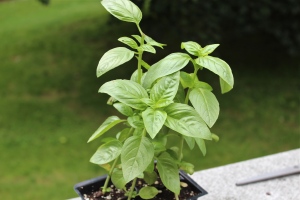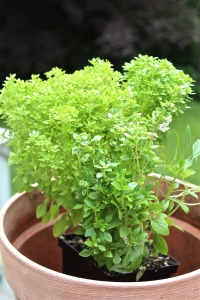
Potted Basil Garden
I think that one of the things I love best about summer is having pots of fresh herbs growing on my back porch. Two that I absolutely must have are basil and parsley. Basil appears in any dish that has tomatoes in it, and parsley makes its appearance in salads, in cooked dishes and as a garnish. Both provide a bright spot of green and color contrast with most foods.

Italian Flat-leaf Parsley
In the past I’ve pretty much stuck with Italian sweet basil and Italian flat-leaf parsley. This year I was a little late getting to the garden center for my plants, and on the day I arrived, a sale was in progress whereby if you bought two of one kind, you got one free. The display of basil(s) was awesome. So of course, I got three; one of my usual kind, and two varieties that were new to me. At such a bargain, I thought it would be fun to experiment with some different kinds.
When a recipe calls for some chopped basil can you use any kind? I think not. A quarter of a cup of one kind is not the same as a quarter cup of another kind. One might be minty, another might be cinnamony, yet another could be lemony. Use the wrong kind and you could wind up spoiling a dish you’ve worked so hard to create. So knowing that there are many (did you know, over sixty?) kinds of basil, I set out to learn about what I had purchased.

Classic Sweet Basil
The most well-known of the basil(s) that are available here are the sweet basils like Italiano Classico. These are the ones that work best in Italian dishes. Take, for example, Caprese Salad. All it needs is olive oil, sweet basil and tomatoes, plus a dash of salt and pepper. Or…Classic pesto: olive oil, salt and pepper, sweet basil, pine nuts, garlic, and grated Romano cheese. Sweet basil is the most common type of basil carried by large retailers and garden centers. It you know basil at all, it’s probably through your experience with sweet basil.

Ruffled Purple Basil
My second type of basil is a purple basil. It has large dark, ruffled leaves. It has the aroma of basil, but a much stronger licorice or anise flavor than sweet basil. This is a very attractive and unusual ornamental basil whose leaves are maroon in color and flowers are pale pink. In addition to its use in recipes, it is also frequently used when making infused vinegars and oils. It makes an attractive garnish because of the dark purple leaves. If this plant grows well, I may attempt making some infused vinegar.

Green Goddess Basil
The third kind I bought is a short dwarf variety that has tiny little leaves. It is called Goddess Basil or Spicy Globe Basil because of its small compact form. It’s leaves are much smaller than most varieties. The flavor is typical for basil, sweet and slightly peppery, but it is very strong. It can be used in most recipes calling for sweet basil.
I planted all three types together in a large pot. I love the look of a large planter on the step, and usually make up several with flowers in them. I hope the basils will grow nicely, and get along together, providing me with some interesting flavor variations in my cooking.
The most important thing to keep in mind when using difference types of basils is to use the variety that best matches the flavors in the dish you are preparing.

Play nice, you guys 🙂





Potted Basil Garden

Ah, sweet basil! It’s so wonderful to lightly brush your hand past the leaves and simply inhale…
Your Basil collection will look wonderful once it gets settled in (and LOVE that gorgeous big white pot: ) My favourite is Thai Basil, but you’ve got to keep it pinched back ’cause, like most Basil, once they’re allowed to set seed, they’re done):
Did you know about the other uses for the Basilicum family? Here’s a bit of info from my favourite plant resource, Plants For A Future (PFAF) from Britain…
http://www.pfaf.org/user/Plant.aspx?LatinName=Ocimum+basilicum
LikeLike